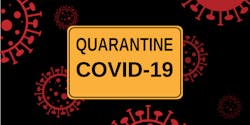WHO COVID-19 technical guidance: Early investigations protocols
The recent emergence of COVID-19 means that understanding of transmission patterns, severity, clinical features and risk factors for infection remains limited, whether among the general population, for health workers or in household and other “closed” settings, according to a statement from the World Health Organization (WHO).
Studies to assess the epidemiology and clinical characteristics of cases in different settings are therefore critical to furthering our understanding of this virus and associated disease. They will also provide the robust information needed to refine the parameters to feed in forecasting models.
These protocols and forms have been designed so that data can be rapidly and systematically collected and shared in a format that facilitates aggregation, tabulation and analysis across different settings globally. We encourage any and all countries and study centers to contribute to this effort regardless of resource availability or patient volume. The ownership of the primary data remains firmly with the individual countries/sites.
Data collected using these investigation protocols will be critical to refine recommendations for case definitions and surveillance, characterize key epidemiological features of COVID-19, help understand spread, severity, spectrum of disease, and impact on the community and to inform guidance for application of countermeasures such as case isolation and contact tracing.
Several early investigation master protocols or master forms for COVID-19 are available for countries including:
1 - The First Few X (FFX) Cases and contact investigation protocol for COVID-19 infection
The following protocol has been designed to investigate the First Few X number of cases and their close contacts (FFX). It is envisioned that the FFX -COVID-19 investigation will be conducted across several countries or sites with geographical and demographical diversity. Using a standardized protocol such as the protocol provided here, epidemiological exposure data and biological samples can be systematically collected and shared rapidly in a format that can be easily aggregated, tabulated and analyzed across many different settings globally for timely estimates of COVID-19 infection . FFX is the primary investigation protocol to be initiated upon identification of the initial laboratory-confirmed cases of COVID-19 in a country.
2 - Household transmission investigation protocol for COVID-19 infection
The household transmission investigation is a case-ascertained prospective study of all identified household contacts of a laboratory confirmed COVID-19 infection. It is intended to provide rapid and early information on the clinical, epidemiological and virological characteristics of COVID-19.
3 - Protocol for assessment of potential risk factors for COVID-19 infection among health care workers in a health care setting
The extent of -COVID-19 infection in healthcare settings is not clear, nor whether there are certain risk factors associated with infection in health care workers. The following protocol has been designed to investigate the extent of infection and risk factors for infection among health care workers. Follow-up and testing of respiratory specimens and serum of health care workers within a facility in which a confirmed case of COVID-19 infection is receiving care can provide useful information on transmissibility and routes of transmission and are important for limiting amplification events in health care facilities.
4 - Population-based age-stratified seroepidemiological investigation protocol for COVID-19 virus infection
This protocol is a population-based, age-stratified prospective study for assessing COVID-19 virus infection. It is intended to provide key epidemiological and serologic characteristics of COVID-19 virus in the general population. This includes the extent of infection in the general population and age-specific infection cumulative incidence, as determined by seropositivity, and the fraction of asymptomatic or subclinical infection
5- Surface sampling of coronavirus disease COVID-19 virus: A practical “how to” protocol for health care and public health professionals
The role of environmental contamination in transmission of COVID-19 virus is currently not clear. This protocol has been designed to determine (viable) virus presence and persistence on fomites in various locations where a patient infected with COVID-19 is currently receiving care or being isolated, and to understand how this may relate to COVID-19 transmission events in these settings. It is therefore important that it is done as part of a comprehensive outbreak investigation and that information obtained by environmental studies is combined with the results of epidemiological, laboratory and sequence data from COVID-19 patient investigations.
6 - Global COVID-19 Clinical Characterization Case Record Form and new data platform for anonymized COVID-19 clinical data
The clinical characterization case record form (clinical CRF) is intended to provide member states with a standardized approach to collect clinical data in order to better understand the natural history of disease and describe clinical phenotypes and treatment interventions (i.e. clinical characterization). By using one standardized clinical data tool, there is potential for clinical data from around the world to be aggregated; in order to learn more to inform the public health response and prepare for large scale clinical trials.
Data platform for anonymized COVID-19 clinical data
In response to the coronavirus disease 2019 (COVID-19) epidemic, the World Health Organization (WHO) is launching a global COVID-19 Anonymized Clinical Data Platform (the “COVID-19 Data Platform”) to enable State Parties to the International Health Regulations (IHR) (2005) to share with WHO anonymized clinical data and information related to patients with suspected or confirmed infections with the 2019-nCoV (collectively “Anonymized COVID-19 Data”).
The Anonymized COVID-19 data received from State Parties through the COVID-19 Data Platform will remain property of the contributing State Party and will be used by WHO for purposes of verification, assessment and assistance pursuant to the IHR (2005), including to inform the public health and clinical operation response in connection with the COVID-19 outbreak.





